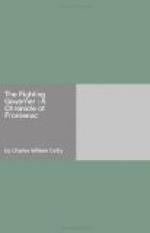Both the seigneur and his tenant, the habitant, had a stake in Canada and helped to maintain the colony in the face of grievous hardships. The courage and tenacity of the French Canadian are attested by what he endured throughout the years when he was fighting for his foothold. And if he suffered, his wife suffered still more. The mother who brought up a large family in the midst of stumps, bears, and Iroquois knew what it was to be resourceful.
Obviously the Canada of 1672 lacked many things—among them the stern resolve which animated the Puritans of New England that their sons should have the rudiments of an education. [Footnote: For example, Harvard College was founded in 1636, and there was a printing-press at Cambridge, Mass., in 1638.] At this point the contrast between New France and New England discloses conflicting ideals of faith and duty. In later years the problem of knowledge assumed larger proportions, but during the period of Frontenac the chief need of Canada was heroism. Possessing this virtue abundantly, Canadians lost no time in lamentations over the lack of books or the lack of wealth. The duty of the hour was such as to exclude all remoter vistas. When called on to defend his hearth and to battle for his race, the Canadian was ready.
CHAPTER II
LOUIS DE BUADE, COMTE DE FRONTENAC
Louis de Buade, Comte de Frontenac et de Palluau, was born in 1620. He was the son of Henri de Buade, a noble at the court of Louis XIII. His mother, Anne de Phelippeaux, came from a stock which in the early Bourbon period furnished France with many officials of high rank, notably Louis de Phelippeaux, Comte de Pontchartrain. His father belonged to a family of southern France whose estates lay originally in Guienne. It was a fortunate incident in the annals of this family that when Antoine de Bourbon became governor of Guienne (1555) Geoffroy de Buade entered his service. Thenceforth the Buades were attached by close ties to the kings of Navarre. Frontenac’s grandfather, Antoine de Buade, figures frequently in the Memoirs of Agrippa d’Aubigne as aide-de-camp to Henry iv; Henri de Buade, Frontenac’s father, was a playmate and close friend of Louis XIII; [Footnote: As an illustration of their intimacy, there is a story that one day when Henry iv was indisposed he had these two boys on his bed, and amused himself by making them fight with each other.] and Frontenac himself was a godson and a namesake of the king.




